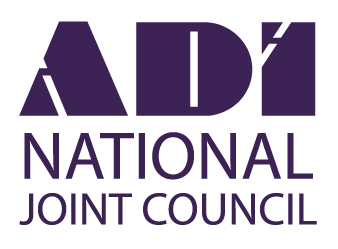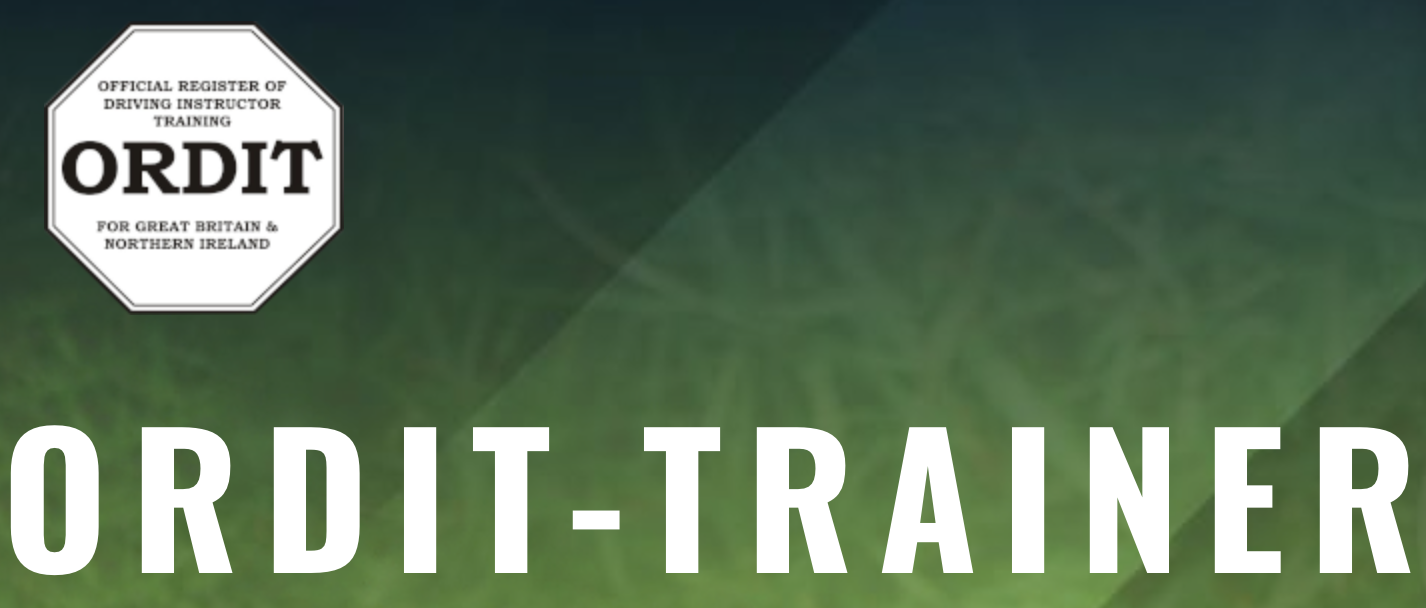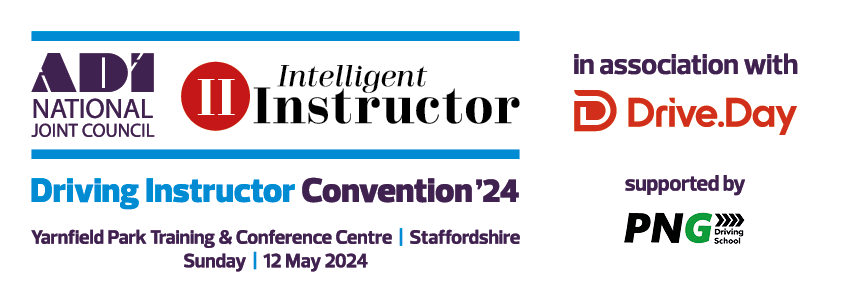Agenda
08:30 – 09:30 Registration
09:30 – 09:35 Welcome address: Richard Storrs, Founder, Intelligent Instructor & Lynne Barrie, President, ADINJC
09:35 – 10:10 Tom Stenson, Head of Training, ADINJC, The f-word (feedback)
10:10 – 10:40 Stewart Lochrie, Founder, Bright Coaching, Coaching the teenage brain
10:40 – 11:00 Tommy Sandhu, Director, Smartlearner Driving School, How to grow your driving school business
11:00 – 11:30 Mid-morning refreshments
11:30 -11:50 Dr Elizabeth Box, Research Director, RAC Foundation, DriveFit: A road safety education intervention supporting future drivers
11:50 – 12:10 Ian Edwards, Managing Director, New View Consultants, Young drivers – impulsivity and road safety
12:10 – 12:30 Olly Tayler QPM, Co-Founder, The Honest Truth, The importance of delivering road safety within lessons
12:30 – 13:30 Lunch
13:30 – 14:05 Lynne Barrie, President, ADINJC, How well do you know yourself?
14:05 – 14:40 Ray Seagrave, Owner, Ray Seagrave Instructor Training, Advanced in-car coaching techniques
14:40 – 15:00 Alisha Khan, Social & Communications Manager, Driving Test Success, The road to one million social media followers
15:00 – 15:30 Mid-afternoon refreshments
15:30 – 16:10 Nick Taylor, ADI Registrar, DVSA, Industry update and Q&A, joined by John Sheridan, Driver Trainer Policy Advisor, DVSA & Amanda Lane, Head of Driver Testing and Driving Policy, DVSA
16:10 – 16:25 Meera Naran MBE, Independent road safety campaigner, How to find hope and never give up
16:25 – 16:30 Closing remarks & conference close, Richard Storrs, Founder, Intelligent Instructor & Lynne Barrie, President, ADINJC

John Sheridan
Driver training policy advisor, DVSA
John Sheridan is one of the most experienced individuals in the driver trainer industry, having joined the DVSA in 1984. John is well-respected by his peers and specialises in ADI and driver training. He worked at Cardington from 1996-2010 as an ADI examiner trainer and now works in policy, influencing the future of ADI driver training. John will accompany his colleagues Nick Taylor and Amanda Lane on stage for an industry update and live Q&A.

Nick Taylor
ADI Registrar, DVSA
Nick Taylor has been a civil servant for over 17 years, with all his roles in and around policy. Nick is proud to have been the ADI Registrar for the past two years, after working as the deputy for five. He is vastly experienced and will run an informative session, updating delegates on developments at the DVSA. It’s a rare opportunity to hear from Nick, who will offer plenty of time for questions from the floor, during this specially extended session.

Lynne Barrie
ADI, ORDIT trainer & President, ADINJC

A former teacher and one of few ADIs to hold a master’s degree in Driver Training, Lynne is a keen advocate of continuing professional development (CPD). She writes books for the profession and enjoys supporting other PDIs and ADIs through her work with the ADINJC as their former Chair, and now as President.
How well do you know yourself as an instructor?
This session will look at the skills needed to make a first-rate driver trainer, enabling instructors to consider their own strengths and how best to use them every day, as a PDI or ADI. Self-knowledge can open up possibilities and help us become happier and better performing. In this session, Lynne will help instructors better understand their true strengths, offering guidance on how to incorporate them into their lessons.

Dr Elizabeth Box
Research Director, RAC Foundation
Elizabeth is an accomplished transport researcher and commissioner with over two decades of experience. She has an excellent track record in influencing and contributing to road safety policy outcomes at the national level. Elizabeth has a PhD in Transport Psychology from Cranfield University, where she focused on developing and trialling pre-driver education interventions grounded in behavioural science.
DriveFit: A road safety education intervention supporting future drivers
This presentation will delve into the evidence-based strategies and educational principles underpinning the award-winning DriveFit intervention. Attendees will gain insights into how this programme addresses the vulnerabilities of young road users as well as how the resources created can be used by driving instructors.

Ian Edwards
Managing Director, New View Consultants
Ian is an award-winning road safety practitioner with over 25 years of experience. He qualified as a driving instructor in 1988, moving into local government as a road safety officer in 1999. Now a researcher, his current projects cover all ages, from preschool children to older drivers.
Young drivers – impulsivity and road safety
The presentation will explore the evaluation findings of a pre-driver driver presentation called ‘Take Control’. The course aims to improve inappropriate impulsive behaviours. Impulsivity is a multidimensional construct defined as “the tendency to act with little forethought, without deliberation and evaluation of consequences”. It has been linked to a wide range of unsafe behaviours, including mobile phone use and drug and drunk driving. ‘Take Control’ was delivered by South Yorkshire’s Safer Roads Partnership and by Wirral Council. The work was funded by the Road Safety Trust.

Alisha Khan
Social & communications manager, Driving Test Success
Over the past two years, Alisha has developed and nurtured her passion for content creation, and as part of the team at Driving Test Success has helped them become one of the top social platforms for learner drivers in the UK.
The road to one million social media followers
Alisha will talk about the journey in helping Driving Test Success grow a social media following to over 1.2 million learner drivers. How this has benefitted their business, and how similar tactics can enhance instructors’ engagement with their new driver audience. This will include tips on organic growth, how to build brand partnerships and the keys to success in working with other instructors and influencers. She will share what learnings (and mistakes) have been made on this journey, with expert advice for instructors who may be interested in developing their social following.

Stewart Lochrie
Founder, Bright Coaching
Stewart is the Founder at Bright Coaching, MD at Caledonian Driver Training, Head of Engagement at the ADINJC, and is currently working on his ILM Level 5 Diploma in Effective Coaching and Mentoring. A lifelong learner and an advocate of coaching young drivers for responsibility and personal growth.
Coaching the teenage brain
Things change. It used to be the case that the best driving instructor was the one with the highest pass rate or the most reviews. Now, more than ever, we need the best driving instructors to be lifelong learners and coaches.
It’s time to update definitions and shift paradigms away from the DVSA. Or even for the DVSA. It’s time for our industry to make more use of the latest research available from the fields of behavioural change and driver psychology, and to put into practice what evidence shows should be our preferred approaches to working with the teenage brain.
Let’s redefine the term “best instructor”. Let’s push things forward!

Meera Naran MBE
Independent road safety campaigner
Meera Naran MBE is an independent road safety campaigner and public speaker helping to ensure we have safer drivers on safer roads. In May 2018 she lost her eight-year-old son Dev in a smart motorway collision on the M6. Since that time, she has successfully campaigned for the adoption of 18 national policy changes with a commitment from the Department for Transport to spend £900m including changes to the Highway Code and on-going driver education.
Meera is currently lobbying for a change in legislation to implement life-saving technology such as autonomous emergency braking, proposed as Dev’s Law. She is also calling for basic life support and CPR to be introduced as a part of the driving test training and continues to campaign with a focus on the safe system approach to ensure that no one else goes through the pain of losing a loved one in the way she and her family did. She is also a Trustee of the road safety charity, BRAKE.
Meera is a qualified Pharmacist and a senior lecturer in postgraduate Clinical Pharmacy at De Montfort University, Leicester.
How to find hope and never give up
This motivational speech will take you through a journey of overcoming challenges, cultivating a mindset of hope, and resilience, and embracing the strength from within. An uplifting session that will leave you feeling motivated and empowered ahead of your journey home.

Ray Seagrave
Owner, Ray Seagrave Instructor Training
With over three decades of experience in guiding individuals towards their goals, both within and beyond the industry, Ray is a well-renowned industry trainer. He is a DVSA Grade ‘A’, excelling since the commencement of the Standards Check. As a Grade ‘A’ (51/51) DVSA ORDIT registered instructor trainer, Ray is highly regarded as an excellent trainer by ADI’s from all over the country. Accredited as a coach and mentor by the International Authority for Coaching and Mentoring (IAPC&M), he conducts nationwide ADI training courses, workshops, and speaks at industry events across the country.
Specialising in DVSA National Driver and Rider standards, Ray empowers driving instructors with effective in-car coaching and teaching techniques. His training courses and mentoring sessions consistently earn exceptional reviews, covering areas such as Standards Check and Part 3 success, Grade ‘A’ training for lesson planning, risk management, teaching, learning strategies, and the essential coaching and teaching skills for success.
Advanced in-car coaching techniques
In this session, Ray explores advanced coaching techniques tailored for ADIs already using coaching. Delve into strategies for fine-tuning your instruction, applying cognitive coaching principles, and achieving higher levels of teaching excellence. If you are already coaching and looking to elevate your instructional skills, this session is designed to help you reach the next level of effectiveness in your teaching.

Tommy Sandhu
Director, SmartLearner Driving School

In Tommy’s two-decade career within the driving industry, he’s taken on diverse roles as an ADI, ORDIT trainer, fleet trainer, and director. His accreditations include ROSPA Gold, Tri Coaching Level 4, IAM Roadsmart advanced driver, and behaviours level 4, all instrumental in founding the West Midlands’ largest, and multi-award winning, independent driving school.
How to grow your driving school business
Immerse yourself in an interactive session designed to illuminate the path to evolving your one-person driving school into a thriving multi-car enterprise. Creating an intimate experience that nurtures the ambitions of those seeking growth, fostering a supportive environment where expertise and experience are freely exchanged, setting you on the journey towards a successful, expanded driving school.

Tom Stenson
Head of Training, ADINJC & ORDIT trainer, ordit-trainer.com

Tom is an ORDIT registered trainer, delivering all aspects of training to PDIs, ADIs and instructor trainers. He sits on the governing committee and is Head of Training at the ADIJNC. He is chair of his local instructor association and has been an ADI for 11 years and has a background in training and sports coaching.
The f-word (feedback)
This session is all about feedback. What feedback is and how to use it in your lessons or sessions? The importance of giving honest feedback, whether it is positive or negative. Examples of how to do this and techniques to take away and develop in your own training.

Olly Tayler QPM
Co-founder, The Honest Truth

After serving 30 years as a police officer, with nearly half that on roads policing, Olly knows all too well the consequences of poor decision-making behind the wheel. Since retiring Olly has returned to road safety, heading up The Honest Truth to help make young drivers as safe as possible.
The importance of delivering road safety as part of a course of driving lessons
Having attended and investigated countless serious and fatal RTCs during his time on roads policing, Olly is only too aware of how one bad decision behind the wheel can lead to catastrophic consequences. With young drivers being massively overrepresented amongst those killed and seriously injured in such RTCs, road safety education as part of a course of driving lessons is a critical part of the learning process. Olly will highlight how ADIs can have a huge influence on a new driver’s attitude and intent when it comes to decision-making behind the wheel for many years after passing their test.












